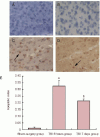JNK3 involvement in nerve cell apoptosis and neurofunctional recovery after traumatic brain injury
- PMID: 25206445
- PMCID: PMC4107806
- DOI: 10.3969/j.issn.1673-5374.2013.16.006
JNK3 involvement in nerve cell apoptosis and neurofunctional recovery after traumatic brain injury
Abstract
Increasing evidence has revealed that the activation of the JNK pathway participates in apoptosis of nerve cells and neurological function recovery after traumatic brain injury. However, which genes in the JNK family are activated and their role in traumatic brain injury remain unclear. Therefore, in this study, in situ end labeling, reverse transcription-PCR and neurological function assessment were adopted to investigate the alteration of JNK1, JNK2 and JNK3 gene expression in cerebral injured rats, and their role in cell apoptosis and neurological function restoration. Results showed that JNK3 expression significantly decreased at 1 and 6 hours and 1 and 7 days post injury, but that JNK1 and JNK2 expression remained unchanged. In addition, the number of apoptotic nerve cells surrounding the injured cerebral cortex gradually reduced over time post injury. The Neurological Severity Scores gradually decreased over 1, 3, 5, 14 and 28 days post injury. These findings suggested that JNK3 expression was downregulated at early stages of brain injury, which may be associated with apoptosis of nerve cells. Downregulation of JNK3 expression may promote the recovery of neurological function following traumatic brain injury.
Keywords: JNK1; JNK2; JNK3; TdT-mediated dUTP nick end labeling; cell apoptosis; neural regeneration; neurological function recovery; neuroregeneration; reverse transcription-PCR; traumatic brain injury.
Conflict of interest statement
Figures



References
-
- Theadom A, Barker-Collo S, Feigin VL, et al. The spectrum captured: a methodological approach to studying incidence and outcomes of traumatic brain injury on a population level. Neuroepidemiology. 2012;38(1):18–29. - PubMed
-
- Dash PK, Kobori N, Moore AN. A molecular description of brain trauma pathophysiology using microarray technology: an overview. Neurochem Res. 2004;29(6):1275–1286. - PubMed
LinkOut - more resources
Full Text Sources
Research Materials
Miscellaneous
